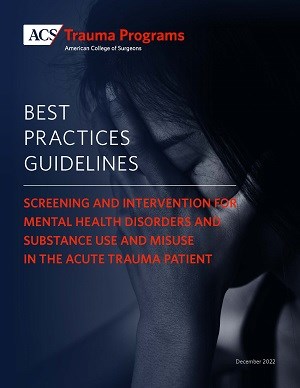A new best practice guideline is available to help healthcare professionals screen trauma patients for mental health disorders and substance misuse.
The evidence-based guideline, Screening and Intervention for Mental Health Disorders and Substance Use and Misuse in the Acute Trauma Patient, is aimed at helping to identify patients most at risk for nonremitting distress, intervene to reduce that risk, and ensure that patients who develop chronic symptoms are connected with best practice treatments. The intent is to improve overall outcomes for trauma patients by providing holistic, multidisciplinary disease-centered care.
“Alcohol and substance use problems are prevalent and increasing among trauma patients,” said Karen J. Brasel, MD, MPH, FACS, professor and vice-chair of the Department of Surgery at Oregon Health & Science University in Portland, during the recent ACS Trauma Quality Improvement Program (TQIP®) conference. “More than 50% of hospitalized trauma patients have reported an alcohol and/or drug use diagnosis during their lifetime. At the time of admission, 20% have met the diagnostic criteria for an alcohol or drug use problem.”
Substance misuse increases the likelihood of complications, mortality, and the need for critical care.
By using screening and intervention protocols such as the Screening, Brief Intervention, and Referral to Treatment (SBIRT) approach, trauma care providers determine which patients are at no/low risk, moderate risk, or severe risk for substance misuse. Depending on the results of the assessment, patients can be given a brief intervention, brief treatment (onsite or via referral), or referral for specialty treatment.
“This guideline will bring all the pieces of the puzzle together so that you can decide how you want to do this in your facility,” said Jorie Klein, MSN, MHA, BSN, RN, director of the EMS Trauma Systems Section at the Texas Department of State Health Services in Austin. She summarized practical steps for implementing the Best Practices Guideline, which include:
- Creating an interdisciplinary stakeholder workgroup
- Conducting a gap analysis to evaluate current practices
- Developing an action plan timeline
- Establishing educational priorities
- Integrating the best practices guidelines into the current Trauma Performance Improvement Patient Safety Plan
- Reporting metrics to trauma operations committee
- Identifying opportunities for improvement
Implementing the best practices guideline at the hospital or systems level begins with wide dissemination of the guidelines, advised Dr. Klein, and should include buy-in from trauma leaders and others involved in quality and performance improvement initiatives.
Download a PDF of the Screening and Treating Mental Health Disorders and Substance Use and Misuse in the Acute Trauma Patient best practice guideline.
Access additional trauma-related best practice guidelines.











